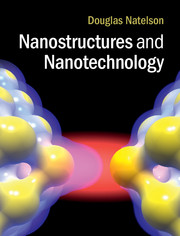Book contents
- Frontmatter
- Contents
- Preface
- Part I
- Part II
- 6 Charge transport and nanoelectronics
- 7 Magnetism and magnetoelectronics
- 8 Photonics
- 9 Micro- and nanomechanics
- 10 Micro- and nanofluidics
- 11 Bionanotechnology: a very brief overview
- 12 Nanotechnology and the future
- Appendix Common quantum mechanics and statistical mechanics results
- References
- Index
8 - Photonics
from Part II
Published online by Cambridge University Press: 05 July 2015
- Frontmatter
- Contents
- Preface
- Part I
- Part II
- 6 Charge transport and nanoelectronics
- 7 Magnetism and magnetoelectronics
- 8 Photonics
- 9 Micro- and nanomechanics
- 10 Micro- and nanofluidics
- 11 Bionanotechnology: a very brief overview
- 12 Nanotechnology and the future
- Appendix Common quantum mechanics and statistical mechanics results
- References
- Index
Summary
We begin this chapter with a brief review of electromagnetic radiation and its interactions with materials and interfaces. We consider nonlinear optical effects, and give an overview of lasers. After a quick review of photonics technology in the context of telecommunications, we consider nanophotonics – optical phenomena involving nanostructured materials. This includes dielectric mirrors and their three-dimensional generalization, photonic band gap structures, as well as plasmonic nanostructures. Research in plasmonics has become extremely fast-paced lately, in part because of the availability of new experimental and computational tools, and in part because of the promise of surface enhanced spectroscopies and more exotic effects such as “perfect” lenses and invisibility cloaks.
As always, entire books have been written on the various components of nanophotonics. Here we will look specifically at the “nano” aspects of these electromagnetic phenomena, with an emphasis on the underlying physics, the synergy between electromagnetic meta materials and electronic structure of materials, and how those ideas lead to rich, fascinating, and useful phenomenology.
Electromagnetic radiation in a nutshell
In the many-photon limit, photonics is better known as the manipulation of classical electromagnetic radiation. All of the interesting effects in nanophotonics originate from underlying equations that govern the interactions of EM radiation and matter, and the electromagnetic response functions of the matter itself. In full generality this can be incredibly messy. Boundary conditions for the E and B fields must be satisfied at all times everywhere, including interfaces between materials that can have very different intrinsic properties. The materials themselves can have electromagnetic response functions (e.g., the dielectric function and the magnetic permeability) that can be tensorial, nonlinear, and strongly dependent on frequency.
Maxwell and waves
Let's start with Maxwell's equations:
∇ · D = ρ, (8.1)
∇ · B = 0, (8.2)
Equation (8.1), with D ≡ ∈E ≡ κ∈0E, and ρ as the volume charge density source term, is nothing more than Gauss' Law.
- Type
- Chapter
- Information
- Nanostructures and Nanotechnology , pp. 357 - 428Publisher: Cambridge University PressPrint publication year: 2015



